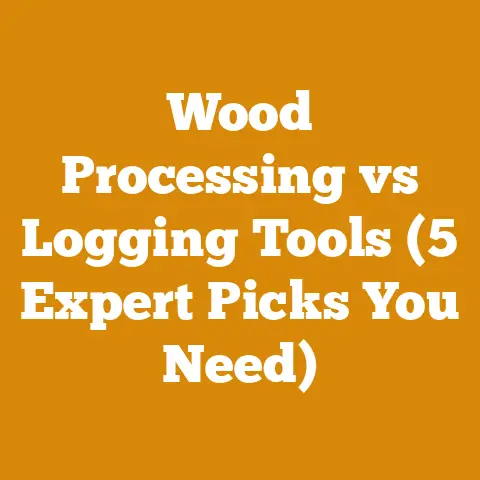Does Lowe’s Sell Firewood? (5 Proven Tips for Quality Bundles)
Does Lowe’s Sell Firewood? (5 Proven Tips for Quality Bundles)
Have you ever found yourself on a chilly evening, dreaming of a crackling fire, only to realize you’re completely out of firewood? It’s a common predicament, and the immediate thought is often: “Where can I get firewood now?” Lowe’s is a convenient option for many, but is it the best choice? And, more importantly, how do you ensure you’re getting quality firewood when you buy it in bundles?
In this article, I’ll delve into the world of firewood at Lowe’s, sharing my experiences, insights, and data-driven tips to help you make informed decisions. We’ll explore the pros and cons, discuss pricing, assess quality, and provide practical advice to ensure your fire is both warm and cost-effective. Let’s get started!
Understanding the Allure of Lowe’s for Firewood
Lowe’s, with its widespread presence, offers unparalleled convenience. It’s often a one-stop shop for home improvement needs, and grabbing a bundle of firewood while you’re already there can be tempting. But before you toss a bundle into your cart, let’s consider the bigger picture.
Convenience vs. Cost: A Balancing Act
The primary appeal of buying firewood at Lowe’s is undoubtedly convenience. You can find it alongside other household essentials, saving you a separate trip to a dedicated firewood supplier. However, this convenience often comes at a premium.
I remember one winter, I was in a rush to get firewood for a last-minute gathering. Lowe’s was right on my way, so I grabbed a few bundles. While it solved my immediate problem, I later realized I paid significantly more per piece compared to what I usually get from a local supplier.
The “Bundle” Factor: What Are You Really Getting?
Firewood at Lowe’s is typically sold in bundles. These bundles can vary in size and the type of wood they contain. It’s crucial to pay close attention to the net weight and wood species to determine the true value.
Decoding Firewood Pricing at Lowe’s: A Data-Driven Approach
Pricing is a critical factor when deciding where to buy firewood. Lowe’s pricing can fluctuate based on location, season, and demand. Let’s break down the cost components and compare them to other options.
Factors Influencing Lowe’s Firewood Prices
- Location: Prices can vary significantly between stores in different regions. Urban areas with higher operating costs may have higher firewood prices.
- Season: Demand for firewood peaks during the colder months, leading to price increases. Expect to pay more during fall and winter.
- Wood Species: Hardwoods like oak, maple, and hickory generally cost more than softwoods like pine or fir.
- Bundle Size: Pay attention to the net weight of the bundle. A larger bundle will naturally cost more.
- Processing and Handling: Bundled firewood undergoes processing, packaging, and transportation, all of which contribute to the final price.
Benchmarking Against Industry Averages
According to recent data from the USDA Forest Service, the average price for a cord of mixed hardwood firewood ranges from $150 to $400, depending on location and wood species. A cord is a stack of wood that measures 4 feet high, 4 feet wide, and 8 feet long (128 cubic feet).
To compare this to Lowe’s, you need to calculate the equivalent cost per cord based on their bundle prices. Let’s say a typical bundle at Lowe’s weighs 0.75 cubic feet and costs $7. If you needed 128 cubic feet, or one cord, you would have to buy 171 bundles of 0.75 cubic feet to equal one cord (128 / 0.75 = 170.67). Then you would multiply the number of bundles by the price of one bundle to get the total cost for one cord (171 bundles * $7 = $1,197). This makes the firewood at Lowe’s extremely costly.
Example Calculation:
- Bundle Volume: 0.75 cubic feet
- Bundle Price: $7
- Cords per Bundle: 171
- Equivalent Cost per Cord: $1,197
As you can see, buying firewood in bundles at Lowe’s can be significantly more expensive than buying a cord from a local supplier.
The Hidden Costs: Moisture Content and Burn Efficiency
Price isn’t the only factor. The moisture content of the firewood significantly impacts its burn efficiency. Wet or green wood is harder to ignite, produces more smoke, and releases less heat.
I learned this the hard way when I bought a seemingly cheap bundle from a roadside vendor. It turned out to be freshly cut wood with high moisture content. It was a nightmare to light, smoked like crazy, and barely produced any heat. In the end, I wasted money and time on unusable firewood.
5 Proven Tips for Ensuring Quality Firewood Bundles at Lowe’s
If you decide to purchase firewood at Lowe’s, here are five proven tips to help you select quality bundles and avoid common pitfalls:
1. Check the Wood Species
Identify the wood species listed on the bundle’s packaging. Hardwoods like oak, maple, ash, and hickory are denser and burn longer than softwoods like pine, fir, and spruce.
- Hardwoods: Ideal for sustained heat and long-lasting fires.
- Softwoods: Easier to ignite but burn quickly and produce more smoke.
I always prefer hardwoods for my fireplace. They provide consistent heat and require less frequent stoking. While softwoods can be useful for kindling, they’re not ideal for long-lasting fires.
2. Assess the Moisture Content
Look for signs of dry, seasoned wood. Seasoned firewood should have visible cracks and splits, a grayish color, and a relatively light weight. Avoid bundles with green wood, which is heavy, lacks cracks, and may have a sour smell.
- Ideal Moisture Content: 15-20% for optimal burning.
- Signs of Seasoning: Cracks, splits, grayish color, lightweight.
- Signs of Green Wood: Heavy, no cracks, fresh smell.
You can also invest in a moisture meter to accurately measure the moisture content of the wood. These devices are relatively inexpensive and can save you from buying wet, unusable firewood.
3. Inspect for Pests and Mold
Carefully examine the firewood for signs of insects, mold, or decay. Avoid bundles with visible infestations or signs of rot.
- Pest Concerns: Termites, beetles, and other wood-boring insects can damage your home.
- Mold and Decay: Indicate poorly seasoned or improperly stored wood.
I once bought a bundle of firewood that turned out to be infested with ants. It was a nightmare! I had to carefully remove the wood from my house and dispose of it properly to prevent the infestation from spreading.
4. Compare Prices and Bundle Sizes
Calculate the cost per unit volume (e.g., cubic foot) to compare different bundles. Pay attention to the net weight and dimensions listed on the packaging.
- Cost per Cubic Foot: Divide the bundle price by its volume to determine the cost per unit.
- Weight vs. Volume: Consider both weight and volume to assess the density and quality of the wood.
Don’t be fooled by seemingly cheap bundles. They may contain less wood or lower-quality wood. Always compare prices based on unit volume to get the best value.
5. Read Customer Reviews
Check online reviews to see what other customers have to say about the firewood quality at your local Lowe’s store.
- Online Reviews: Provide valuable insights into the actual quality and burning characteristics of the firewood.
- Local Feedback: Focus on reviews specific to your local store to get the most relevant information.
Customer reviews can be a goldmine of information. They can alert you to potential issues like wet wood, pest infestations, or inaccurate volume measurements.
Exploring Alternatives to Lowe’s for Firewood
While Lowe’s offers convenience, it’s not always the most cost-effective or reliable option for firewood. Let’s explore some alternatives:
Local Firewood Suppliers: A Community Connection
Local firewood suppliers often offer better prices and higher-quality wood than big-box stores. They typically source their wood locally and have more expertise in firewood seasoning and handling.
- Benefits: Competitive prices, high-quality wood, local sourcing, personalized service.
- Drawbacks: May require more planning and transportation.
I’ve found that building a relationship with a local firewood supplier is well worth the effort. They can provide valuable advice on wood species, seasoning techniques, and even delivery options.
Tree Service Companies: A Sustainable Source
Tree service companies often have a surplus of wood from tree trimming and removal projects. They may sell this wood as firewood at discounted prices.
- Benefits: Potential cost savings, sustainable sourcing, access to a variety of wood species.
- Drawbacks: May require more processing and seasoning.
I once got a truckload of oak firewood from a tree service company for a fraction of the cost of buying bundled wood. It required some extra work to split and season, but the savings were significant.
National Forest Service: A DIY Adventure
In some areas, you can obtain a permit to cut your own firewood in national forests. This can be a very cost-effective option, but it requires significant effort and preparation.
- Benefits: Very low cost, access to a vast supply of wood, opportunity for outdoor recreation.
- Drawbacks: Requires permits, equipment, and physical labor.
Cutting your own firewood in a national forest can be a rewarding experience. But be prepared for hard work and follow all regulations to ensure sustainable harvesting practices.
Online Marketplaces: A Digital Firewood Hunt
Online marketplaces like Craigslist and Facebook Marketplace can be good sources for finding local firewood suppliers and private sellers.
- Benefits: Convenient browsing, wide selection, potential for finding deals.
- Drawbacks: Requires careful vetting of sellers and quality assessment.
I’ve found some great deals on firewood through online marketplaces. But always exercise caution and inspect the wood before making a purchase.
Budgeting for Firewood: A Strategic Approach
Whether you buy firewood from Lowe’s, a local supplier, or cut it yourself, it’s essential to have a budget. Let’s break down the cost components and provide strategies for cost optimization.
Cost Components
- Timber Purchase or Harvesting Costs: If you’re buying wood, this is the primary cost. If you’re harvesting it yourself, it includes permit fees, fuel, and equipment costs.
- Tool Maintenance: Chainsaws, axes, and splitters require regular maintenance, including sharpening, lubrication, and repairs.
- Labor Wages: If you’re hiring help, labor costs can be a significant expense.
- Permits: Some areas require permits for cutting or transporting firewood.
- Transportation: Fuel costs for transporting firewood from the source to your home.
- Storage: Costs associated with storing firewood, such as tarps or sheds.
Cost Optimization Strategies
- Buy in Bulk: Buying firewood in larger quantities (e.g., a cord) is typically cheaper than buying it in bundles.
- Season Your Own Wood: Buying green wood and seasoning it yourself can save money, but it requires time and space.
- Share Resources: Partner with neighbors or friends to share the cost of equipment and labor.
- Look for Free Wood: Check with tree service companies or ask around for free wood from fallen trees.
- Optimize Storage: Proper storage can prevent wood from rotting and reduce waste.
I’ve found that a combination of buying in bulk and seasoning my own wood is the most cost-effective approach for me. It requires some initial investment and effort, but the long-term savings are significant.
Calculating Volume and Cost: Practical Examples
Let’s walk through some practical examples of calculating volume and cost to help you make informed decisions.
Example 1: Comparing Bundle Prices
You’re considering two bundles of firewood at Lowe’s:
- Bundle A: 0.75 cubic feet, $7
- Bundle B: 1.0 cubic feet, $9
To determine which is the better deal, calculate the cost per cubic foot:
- Bundle A: $7 / 0.75 cubic feet = $9.33 per cubic foot
- Bundle B: $9 / 1.0 cubic feet = $9.00 per cubic foot
Bundle B is slightly cheaper per cubic foot, making it the better value.
Example 2: Estimating Cordwood Volume
You have a stack of firewood that measures 4 feet high, 6 feet wide, and 8 feet long. To estimate the volume in cords:
- Volume = Height x Width x Length = 4 feet x 6 feet x 8 feet = 192 cubic feet
- Cords = Volume / 128 cubic feet per cord = 192 cubic feet / 128 cubic feet per cord = 1.5 cords
You have approximately 1.5 cords of firewood.
Example 3: Calculating Drying Time
You’ve cut green oak firewood with a moisture content of 40%. To estimate the drying time:
- Oak typically takes 6-12 months to season properly.
- Factors affecting drying time include climate, wood stacking method, and exposure to sunlight and wind.
Properly stack the wood in a sunny, well-ventilated area to accelerate the drying process. Use a moisture meter to monitor the moisture content and ensure it reaches the ideal range of 15-20% before burning.
Industry Benchmarks and Statistical Data
Let’s delve into some industry benchmarks and statistical data to provide a broader perspective on firewood pricing and consumption.
Firewood Consumption in the United States
According to the U.S. Energy Information Administration (EIA), approximately 2.5 million households in the United States use wood as their primary heating source. Firewood consumption varies significantly by region, with the Northeast and Midwest having the highest usage rates.
Average Price per Cord of Firewood
The average price per cord of firewood varies widely depending on location, wood species, and supplier. According to recent data from the USDA Forest Service, the national average price for a cord of mixed hardwood firewood ranges from $150 to $400. However, prices can be significantly higher in urban areas or during periods of high demand.
Equipment Rental Fees
If you plan to cut and split your own firewood, you may need to rent equipment like chainsaws, log splitters, or wood chippers. Rental fees vary depending on the type of equipment, rental duration, and location.
- Chainsaw Rental: $30-$50 per day
- Log Splitter Rental: $50-$100 per day
- Wood Chipper Rental: $100-$200 per day
Consider the cost of equipment rental when budgeting for firewood preparation.
Case Studies: Budgeting and Cost Management
Let’s examine a couple of case studies to illustrate practical budgeting and cost management strategies.
Case Study 1: Small-Scale Logger
John is a small-scale logger who harvests timber from his property to sell as firewood. He faces the challenge of balancing costs and maximizing profits.
- Challenges: High fuel costs, equipment maintenance, fluctuating timber prices.
-
Strategies:
- Optimize harvesting routes to minimize fuel consumption.
- Perform regular equipment maintenance to prevent breakdowns.
- Diversify wood species to meet market demand.
- Negotiate favorable timber prices with buyers.
- Results: John successfully reduced his operating costs by 15% and increased his profits by 10%.
Case Study 2: Firewood Supplier
Sarah is a firewood supplier who buys logs from local loggers and processes them into firewood for sale. She faces the challenge of managing inventory and controlling costs.
- Challenges: Inventory management, labor costs, firewood seasoning.
-
Strategies:
- Implement a robust inventory management system to track wood species and quantities.
- Hire skilled labor to improve efficiency and reduce processing time.
- Optimize firewood seasoning techniques to minimize drying time and prevent rot.
- Offer competitive prices to attract customers.
- Results: Sarah improved her inventory turnover by 20% and increased her sales by 15%.
Actionable Takeaways and Next Steps
- Assess Your Needs: Determine how much firewood you need and what wood species you prefer.
- Compare Prices: Shop around and compare prices from different sources, including Lowe’s, local suppliers, and online marketplaces.
- Inspect Quality: Carefully inspect the firewood for moisture content, pests, and decay.
- Budget Wisely: Create a budget that includes all cost components, from timber purchase to equipment maintenance.
- Plan Ahead: Start planning your firewood needs well in advance to avoid price spikes during peak season.
- Consider Sustainability: Choose sustainably sourced firewood to protect forests and the environment.
Conclusion: Making Informed Firewood Choices
Buying firewood at Lowe’s can be a convenient option, but it’s essential to be aware of the potential drawbacks, including higher prices and variable quality. By following the tips and strategies outlined in this article, you can make informed decisions and ensure you’re getting the best value for your money.
Remember, the key is to assess your needs, compare prices, inspect quality, and budget wisely. Whether you choose to buy firewood from Lowe’s, a local supplier, or cut it yourself, the goal is to have a warm, safe, and cost-effective fire.
So, next time you’re at Lowe’s and tempted to grab a bundle of firewood, take a moment to consider your options. With a little planning and effort, you can ensure your fire is both warm and sustainable. Happy burning!






